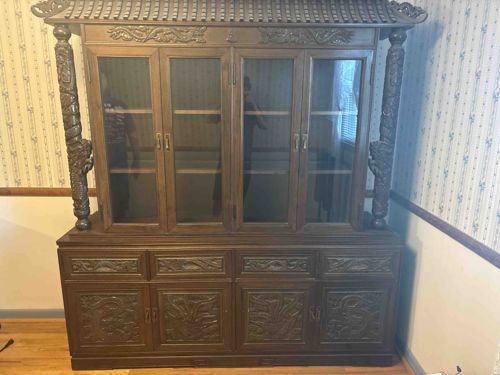
East Asian Inspired Carved Hardwood Display Hutch / Cabinet
This is a substantial multi-part hutch, likely constructed from a dark-stained hardwood, possibly oak or a similar durable timber given its carved elements and overall robust appearance. The hutch features an ornate, pagodal-style roof with multiple tiered sections, mimicking roof tiles, and decorative carvings along its edge, including what appears to be a dragon motif above the upper cabinet doors. Two heavily carved, fluted columns with distinct dragon or 'foo dog' like figures wrapping around them flank the upper display cabinet, providing structural support and significant aesthetic detail. The upper section consists of four glass-fronted doors, revealing visible interior shelving, suggesting its use for display. The glass panels are set within wooden frames, showing internal reflections consistent with clear glass. The lower section is a credenza-style base with a combination of drawers and cabinet doors. There are four drawers visible across the top of this lower section, featuring recessed, likely carved, panels. Below the drawers are four cabinet doors, each adorned with deeply carved, possibly floral or nature-inspired, relief designs. The hardware, visible on both upper and lower doors, appears to be simple, vertical metal pulls. The overall color is a consistent rich, dark brown, indicative of a stain or natural aging of the wood. The craftsmanship appears to be of high quality, with intricate and detailed carvings throughout. There are no immediately apparent signs of significant damage or wear from the provided image, but a full appraisal would require closer inspection for nicks, scratches, or structural integrity. The style strongly suggests an East Asian influence, specifically Chinese or Japanese, with its characteristic roofline and mythical creature carvings. The detailed and robust construction points to a likely late 19th or early 20th-century origin, or a more recent reproduction in a traditional style.
AI-Generated Appraisal Disclaimer
Estimated Value
$2,500 - $3,500
Basic Information
Category
Furniture
Appraised On
December 6, 2025
Estimated Value
$2,500 - $3,500
Additional Details Provided By Owner
User Provided Information
Japanese hutch
Item Description
This is a substantial multi-part hutch, likely constructed from a dark-stained hardwood, possibly oak or a similar durable timber given its carved elements and overall robust appearance. The hutch features an ornate, pagodal-style roof with multiple tiered sections, mimicking roof tiles, and decorative carvings along its edge, including what appears to be a dragon motif above the upper cabinet doors. Two heavily carved, fluted columns with distinct dragon or 'foo dog' like figures wrapping around them flank the upper display cabinet, providing structural support and significant aesthetic detail. The upper section consists of four glass-fronted doors, revealing visible interior shelving, suggesting its use for display. The glass panels are set within wooden frames, showing internal reflections consistent with clear glass. The lower section is a credenza-style base with a combination of drawers and cabinet doors. There are four drawers visible across the top of this lower section, featuring recessed, likely carved, panels. Below the drawers are four cabinet doors, each adorned with deeply carved, possibly floral or nature-inspired, relief designs. The hardware, visible on both upper and lower doors, appears to be simple, vertical metal pulls. The overall color is a consistent rich, dark brown, indicative of a stain or natural aging of the wood. The craftsmanship appears to be of high quality, with intricate and detailed carvings throughout. There are no immediately apparent signs of significant damage or wear from the provided image, but a full appraisal would require closer inspection for nicks, scratches, or structural integrity. The style strongly suggests an East Asian influence, specifically Chinese or Japanese, with its characteristic roofline and mythical creature carvings. The detailed and robust construction points to a likely late 19th or early 20th-century origin, or a more recent reproduction in a traditional style.
Related Tags
Explore similar items and categories:
Get Your Items Appraised
Instant estimates of your treasures with AI-powered instant appraisals